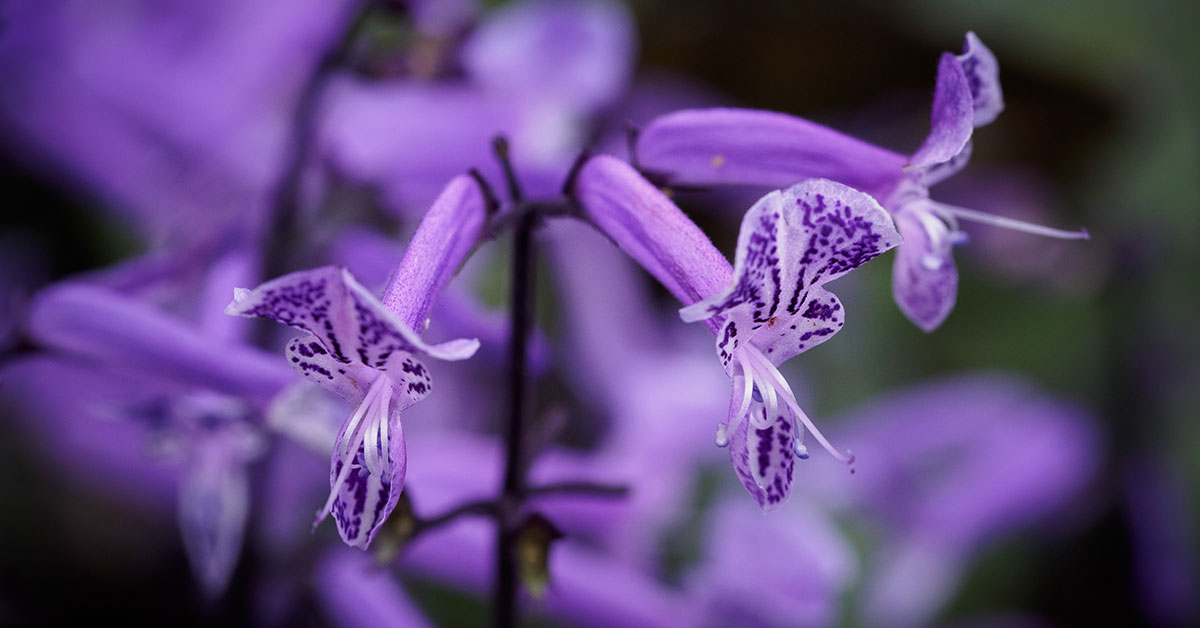Spurflowers are a bushy perennial that is often used as ground cover. There are many varieties of spurflower, most have dense green foliage with individual ovate leaves. Its flowers range in color and shape but all varieties have many flowers per branch.
These bushes can thrive in both soil and containers and do not require complicated soil. Keeping them in containers or flower beds is a great way to keep them contained as they will aggressively take over available space.
What is Spurflower?
Spur flowers are easy to grow and maintain. They have drought tolerance and no specific needs for soil. This makes them ideal for beginner gardeners. They bloom later than many other flowers, lasting from late summer to early fall.
- Scientific Name: Plectranthus
- Other Names: Cockspur flower, Creeping Charlie, Lobster bush
- Native to: South Africa
- Invasiveness: Yes
- Tenderness: Frost tender
- Sun: Partial shade or full sun
- Water: Keep soil moist
- Soil: Well-drained, organic matter-rich soil, neutral to acidic pH
- Hardiness Zone: USDA 9-11
- When to Plant: Spring or early summer
- Spacing: 1-3 feet apart
- Plant Height: Grows up to 6 to 9 feet depending on the variety
- Bloom Period: late summer to early fall
- Time to Maturity: 6 months to 1 year
- Container Friendly: Yes
- Fertilizer: Not necessary, can benefit from water-soluble fertilizer in the growing season
- Toxicity: Non-toxic
- Drought Tolerant: Yes
- Deer Resistant: Yes
- Pest Resistant: Yes
Spurflower is a fast-growing, frost-tender perennial native to South Africa. It is typically found in forests so it prefers dappled or partial shade but can endure the full sun. Its soil needs to be kept moist but allow the top inch or two to dry out before rewatering. Spurflowers don’t need much in the way of fertilizer, an all-purpose, water-soluble fertilizer can be applied 1 to 2 months before its growing season in summer and early fall.
It blooms in the summer and early fall months, producing many flowers. Plant in spring or early summer, spacing 2 to 3 feet apart, as it can grow up to 6 to 9 feet tall. It covers ground aggressively so regular pruning will be necessary.
Growing Spurflower in Containers
No matter where spurflower is planted you will need to keep it in check. If you plant them in containers such as pots or flower beds you can keep their outward growth in check and only have to worry about their height. Spurflowers even do very well indoors as long as their light needs are met. I find it easier to control the sunlight indoors. It can handle a full day of bright, indirect lighting or about 4 to 6 hours of direct light. If moving your spurflower outdoors be wary of sunburns. Sometimes they will need a speedy acclimation period before going outside full-time.
When to Plant Spurflower
Spurflower’s growing season is from summer to early fall, so the best time to plant them is in the spring or early summer. This will give them time to establish themselves before the growing season allowing them to maximize that energy. If sowing indoors start your seeds 4 to 6 weeks before the last freeze of the season.
How to Plant Spurflower Seeds
Spurflower seeds are very easy to sow. They don’t have to be covered or buried at all. Leep the seeds above 65 degrees and keep them moist. Plant 2 seeds for ever 1 desired plant. Place the seeds on top of soil similar to it’s parents, well-drained with organic material. Germination is fast and should only take about a week.
How to Collect Spurflower Seeds
I prefer to propagate most plants through cutting or grafting as it is faster and ensures that the colors of the flowers and the shape of the leaves remain the same. That said, you can easily harvest your spurflower seeds for gifts or future use. Keep a close eye once your spurflower starts to bloom. Wait until the end of the bloom period or when the flowers begin to die and dry out. When this starts to happen go out everysooften with a plate or other flat surface and gently pull on the flowers that are all dried up. If they pop right off then they are ready. Let them dry out completely.
Once dry, gently roll the flowers around over a plate or similar surface. The seeds should fall right out! Remove any debris and store them in an envelope or ziplock baggie. be sure to label them with the harvest date and variety!
How to Propagate
You don’t need seeds to propagate a spurflower. You can grow another plant for a cutting taken from a healthy adult plant. To start take a sterile pair of shears and cut off a 4 to a 6-inch segment of a branch that has fully matured leaves. The removed segment should have 4 to 6 leaves on it. Remove the bottom 2 or 3 leaves, leaving leaves toward the top on the end of the cutting. Plant in a 6-inch deep pot with drainage holes. Make sure the soil line covers where the bottom leaves used to be. Water thoroughly and place in a location similar to its parent.
Wildlife Attracted by Spurflower
Hummingbirds and bees are attracted to spurflower for their colorful and fragrant flowers. Teh nectar and pollen within are irresistible to these pollinators. With both of these pollinators favoring your garden, all the plants there will thrive.
Common Problems
Spurflowers may be resilient and easy to grow but they can still have issues. Common pests to this plant are spider mites and mealy bugs. A gentle pesticide can clear them up expeditiously. Be sure to inspect your plants thoroughly before bringing them inside.
Fungal and bacterial infections can appear as black or brown spots on the leaves. An anti-bacterial fungicide can solve both to be doubly sure.













